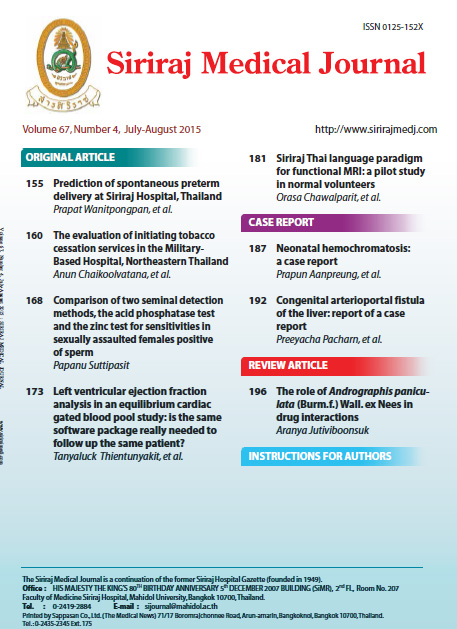Comparison of Two Seminal Detection Methods, The Acid Phosphatase Test and The Zinc Test for Sensitivities in Sexually Assaulted Females Positive of Sperm
Abstract
Objective: To determine (1) the duration for which sperm, acid phosphatase, and zinc could be detected; (2) the sensitivities of the acid phosphatase and zinc tests; and (3) the preferred screening tests to provide evidence of sexual assaultin females.
Methods: The results of acid phosphatase and zinc tests from cases over the last 10 years were retrieved if they met the following criteria: (1) results of acid phosphatase and zinc tests performed in females who were sexually assaulted by males; (2) sperm was detected in the genitals; and (3) the time between sexual assault and evidence collection was recorded. Data were analyzed using McNemar’s test and chi-square with Bonferroni correction.
Results: The best chance of detecting sperm in females is within 24 h of assault. The sensitivities of the acid phosphatase and zinc test were greatest at 24 h, although the sensitivities were only 78.1% and 28.5%, respectively, at this time. The sensitivity of the acid phosphatase test was much greater than that of the zinc test.
Conclusion: This study revealed that the zinc test has a low sensitivity and is unsuitable as a screening test of sexual assault. The acid phosphatase test has a moderate sensitivity and is more suitable as a screening test of sexual assault. Other screening tests with greater sensitivities are needed to provide evidence of sexual assault. These results also suggest that the evidence collection should be performed within 24 h of sexual assault.
Keywords: Sexual assault, acid phosphatase test, zinc test, sensitivity
Downloads
Published
How to Cite
Issue
Section
License
Authors who publish with this journal agree to the following conditions:
Copyright Transfer
In submitting a manuscript, the authors acknowledge that the work will become the copyrighted property of Siriraj Medical Journal upon publication.
License
Articles are licensed under a Creative Commons Attribution-NonCommercial-NoDerivatives 4.0 International License (CC BY-NC-ND 4.0). This license allows for the sharing of the work for non-commercial purposes with proper attribution to the authors and the journal. However, it does not permit modifications or the creation of derivative works.
Sharing and Access
Authors are encouraged to share their article on their personal or institutional websites and through other non-commercial platforms. Doing so can increase readership and citations.










